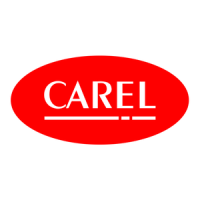S&2ð
cod. Carel +030221826 rel. 2.0 dated 03/10/02
34
3ULYDWHVKDUHGWHUPLQDOV
Each pCO
2
board, connected to the network, can manage more than one terminal (max 3). 7KHGLVSOD\RIWKHYDOXHVRQHDFK
WKHVHRFFXUVVLPXOWDQHRXVO\DQGQRWLQGHSHQGHQWO\IURPRQHDQRWKHU it is like having a series of keypads and dispalys
connected in parallel.
Each terminal associated to a specific board can be SULYDWHRUVKDUHGA WHUPLQDO is considered SULYDWHif it alone displays the
output of just one I/O board. A WHUPLQDO is considered VKDUHG if, either automatically or via keypad, it can be switched between
a number of control boards.
on/off
enteralarm
on/off
enteralar m
pCO² 1
3HUVRQDO
6KDUHG
on/off
enteral arm
3HUVRQDO
)LJ
Each pCO
2
constantly updates the display of its private terminals, on the other hand, are only updated if the pCO
2
in question is
currently controlling it. This is described in the following ORJLFDOGLDJUDP Fig. 5.3.1.
In this example the shared terminal is associated to 4 I/O boards, yet at this moment only no. 1 can display data and receive
commands from it. Switching of the boards occurs, in cyclical order (→→→→....), by pressing a button set by the
application program.
Switching can occur automatically on request, guided by the program. For example, an I/O board may request control of the
shared terminal to display alarms or , alternatively, relinquish control to the next board after a set interval (cyclical rotation).
7KHQXPEHUDQGW\SHRIWHUPLQDOVLVHVWDEOLVKHGGXULQJWKHLQLWLDOFRQILJXUDWLRQRIWKHQHWZRUN7KHUHODWLYHGDWDLV
VWRUHGLQWKHSHUPDQHQWPHPRU\RIHDFK,2ERDUG

